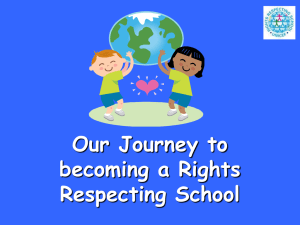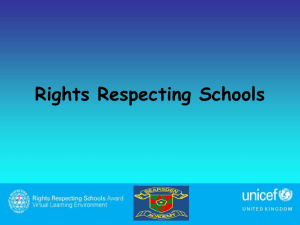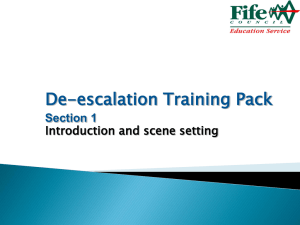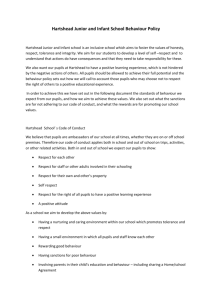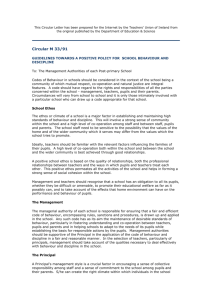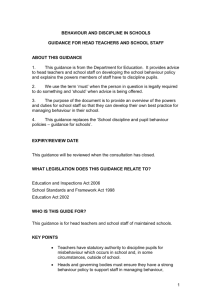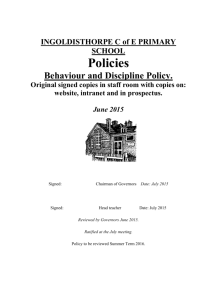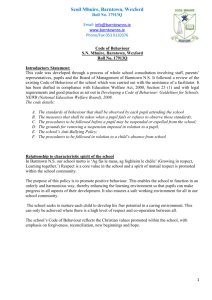RRSA Power Point
advertisement
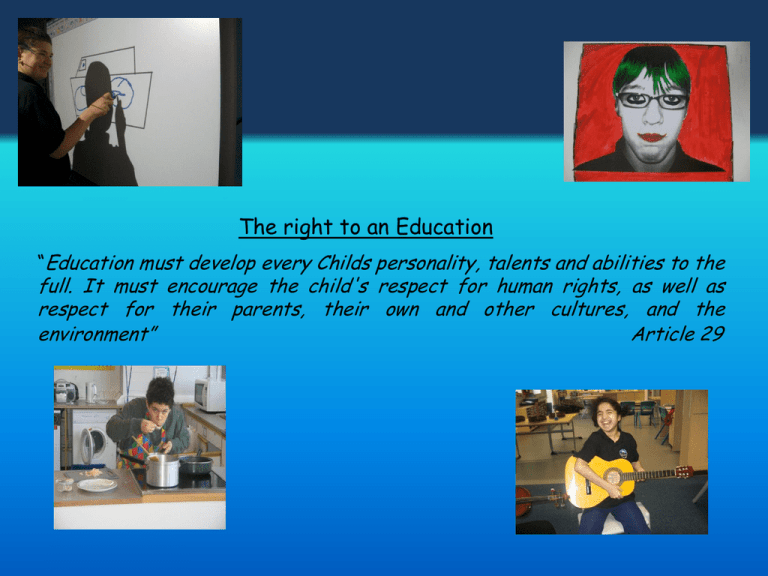
The right to an Education “Education must develop every Childs personality, talents and abilities to the full. It must encourage the child's respect for human rights, as well as respect for their parents, their own and other cultures, and the environment” Article 29 •The UNCRC (United Nations Convention for the Rights of the Child) provides the framework for UNICEFS (world’s leading organization focusing on children and child rights) Rights Respecting Schools award. •Through the RRSA, UNICEF seeks to help children apply the values and principles of the UNCRC to improve their quality of life. •The RRSA puts children's rights at the heart of a schools culture and ethos. The RRSA looks at behaviour in a holistic way. There is a clear move from the teacher managing a child's behaviour, to helping children use the knowledge of the UNCRC to manage their own behaviour. “All children have a right to relax and play and to join a wide range of activities” Article 31 “Children have the right to meet together and to join groups and organisations, as long as this does not stop other people from enjoying their rights” Article 15 • provides schools with a framework of values which strengthen the intended outcomes of the ECM (every Child Matters) • aims to ensure that every child whatever their background and circumstances have the support they need to be Healthy, Stay safe, Enjoy and Achieve, Make a positive contribution Achieve Economical well being. “Children have a right to learn and use the language and customs of their families, whether these are shared by the majority of people in the country or not”. Article 24 “Children have the right to think and believe what they want, and to practise their religion, as long as they are not stopping other people from enjoying their rights.” Article 14 Placing the UN Convention on the Rights of the Child at the heart the school’s core values and ethos provides a coherent framework for other whole-school statutory requirements. “Everyone under 18 years of age has all the rights in the Convention, whatever their race, religion, abilities, whatever they think or say, whatever type of family they come from.” Articles 1 and 2 • they have rights • what these rights are • the rights of others • to understand the consequences of their own and others actions. • Participation skills and skills to show expressions • How to develop an understanding of fairness • How to communicate ideas and appreciate the ideas of others. The right to a childhood “Every Child has the right to a safe childhood. Every child has the right to be properly cared for and protected from violence, abuse and neglect by their parents, or anyone” Article 19 Through Teaching agreed values pupils: voice is heard. Pupils know, understand and make a positive contribution to the way in which the school is run. take individual and collective responsibility for their behaviour. show care and increased levels of tolerance. are actively involved in reviewing and evaluating work are aware of the language used in a RRS and use it as part of everyday use. make good judgements and have good ideas about fairness and democracy. have good relationships with staff in school. All staff (Teachers, TAs, Site manager, Cleaning staff, Admin, etc) model rights respecting language and behaviour Choice and consequence have a positive effect Displays link articles from the UNCRC The right to a voice “Children have the right to say what they think should happen, when adults are making decisions that affect them and to have their opinions taken into account.” Article 12 Aspects of RRSA embedded in Seal/ PSCHE Restorative approach taken Team Teach Pupil Voice – School Council/ Anti-bullying Group / Inclusion (OLHS/NRHS) termly pupil evaluations/ School Wardens Individual personalised timetables/ Communication Booklets/ Individual social stories Lunchtime clubs (promoting choice) / After school club Healthy Schools Award Eco Schools Code of conduct embedded Assemblies‘ Solution focused school approach Webster Stratton Reward system in place Calm rooms and work room established Pupil Repair and reflection used after an incident Parents group Embed RRS language and ethos into the curriculum, school policies and practice, work with parents group to establish awareness and understanding work with the wider community (partner s) Launch Assembly in school to promote whole school understanding (June 2010) Super learning day (June 2010) – KS4/5, Ks3 School Displays to recognise articles/appropriate language More direct teaching ; Rights responsibilities/ needs/ wants •Increased pupils knowledge of what are rights •respect the rights of others locally, nationally and globally. •Enhanced moral development •Improved behaviour and relationships (reducing bullying/ exclusions/ improve attendance) •Improved self esteem •Positive attitudes to diversity in society •Participation in decision making •Improved learning environment Teachers are confident in prompting pupils to reflect on a situation from a rights respecting point of view. They encourage pupils to deal with incidents and take ownership for their actions rather than the “don't do that” type of exchange. Label desired behaviour in terms of “rights” and “responsibilities” (rather than things being good or wrong) Model behaviour and vocabulary Offer increased choice regarding learning activities Direct teaching about rights Greater use of role play, to explore rights and Responsibilities Enhanced job satisfaction Classroom code of conduct agreed /signed expressed in terms of rights and responsibilities Pupils - give teachers feedback regularly on what helps them learn. are involved in assessment and evaluation are responsible for aspects of classroom organisation have opportunities to make choices about what they learn There is an emphasis on mutual support and collaboration There is a wide variety of teaching strategies and routes to learning. Behaviour improves and is reinforced with fair, consistent consequences. Displays reinforce awareness of rights respect and responsibilities Staff are valued and respected – positive relationships are maintained - staff model rights respecting behaviour. Staff – actively listen to and show respect for pupil views and options. avoid put downs and sarcasm give clear reasons for consequences avoid “blanket” consequences for the whole class when individuals have misbehaved Shared decision making: Ideas and expertise are shared, building capacity participation and communication in the SLT Atmosphere of openness and trust Encourages whole school involvement and the empowerment of all staff, pupils and the wider community. “Sharing the same framework with a partner school improves transition, continuity and progression. This in turn can reduce the anxiety pupils with additional needs have when they move school and improves their ability to be ready to learn”. Share and model good practice Provide in-reach for all professionals in partner schools to observe strategies and interventions used. Provide appropriate and alternative resources Provide training on effective behaviour management and other strategies used at NRHS (restorative/team teach) Build networks and supporting collaboration Think..... Instead of looking at ways that staff can manage pupils behaviour a child's “right approach” looks at the question.................................. “How can we all model rights respecting relationships so that children can learn from us, and from each other, how to make right respecting choices in all their own relationships?”
